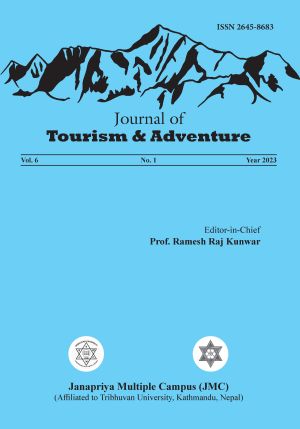The Trans-Himalayan Livelihood: Opportunities and Challenges in Tourism Development in Upper Mustang, Nepal
DOI:
https://doi.org/10.3126/jota.v6i1.58560Keywords:
Food preferences, livelihood, local organic food of Upper Mustang, spiritual practices, Tibetan cultureAbstract
The people, places, and livelihoods of the Himalayan regions in Nepal are great attractions to tourists for multiple activities. However, mountain livelihood as tourist product has been little attention. This paper aims to present the Loba livelihood of the Upper Mustang, a trans-Himalayan region of Nepal as an intangible heritage, where the Government of Nepal began high-yielding tourism in 1992. Similarly, it focuses on opportunities and challenges of tourism development in the Upper Mustang. The paper is based on anthropological fieldwork conducted for the PhD, at Tribhuvan University, Nepal. The qualitative data were collected by applying observation and interview methods. The quantitative data were collected by Annapurna Conservation Area Project, Lo-manthang, and Jomsom. The important observable tourist goods in the study area include scenic desert-like natural surroundings, sacred sites, Himalayan festivals, rituals, local organic food items, and high altitude agricultural and pastoral practices. Similarly, the visitors are amazed and attracted by these tangible as well as intangible cultural heritages of Loba. The heritage includes the “mud-walled city of Lo-manthang”, medieval monasteries, palaces, and cave dwellings. The Loba livelihood is unique and a great attraction to domestic as well as international tourists for those who have no opportunity to experience a similar livelihood elsewhere. According to the Annapurna Conservation Area Project (ACAP), Lo-manthang Unit Office records 52559 (1992-2019) foreign tourists visited Upper Mustang, which is increasing by 144 tourists per year. This study contributes to the local, provincial, and federal governments to plan further development of tourism in the Himalayan region.
Downloads
Downloads
Published
How to Cite
Issue
Section
License
Authors retain the copyright of their articles.




